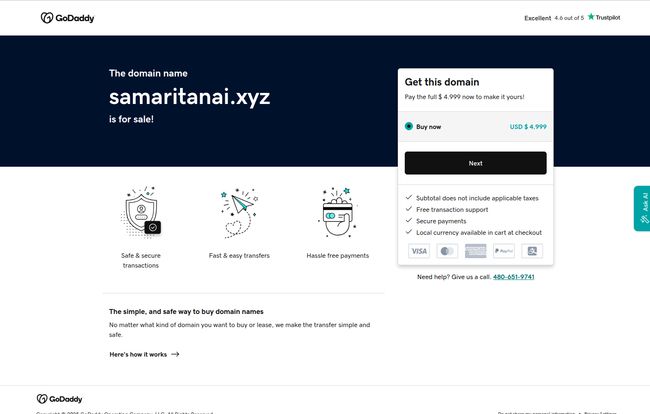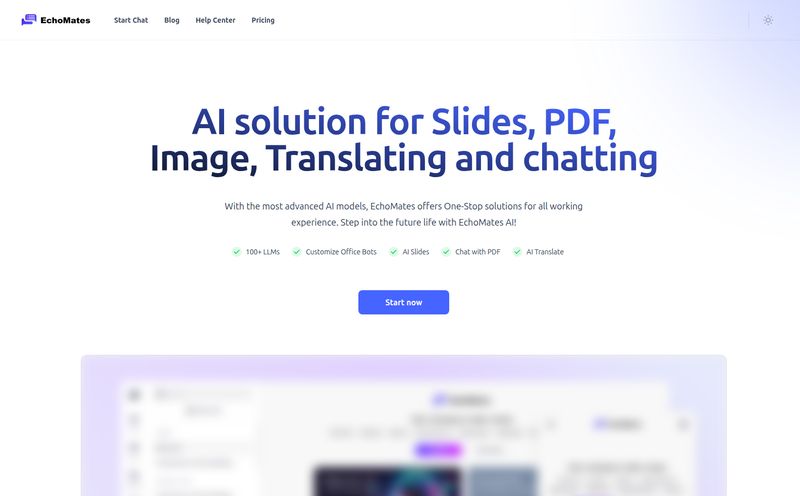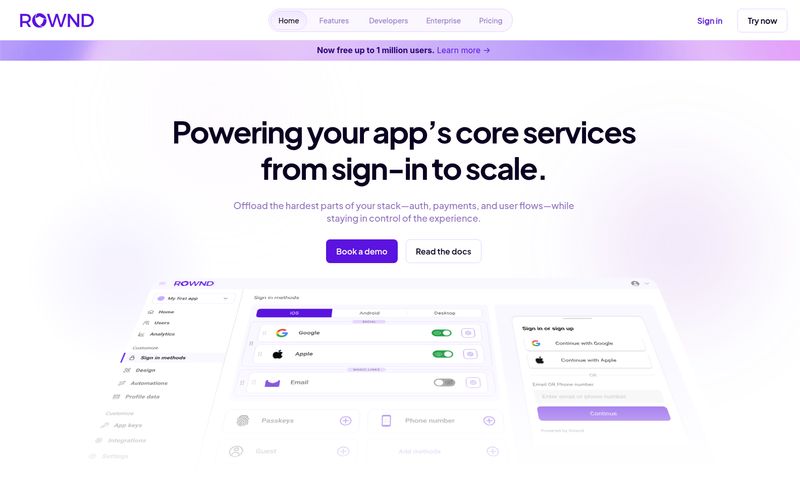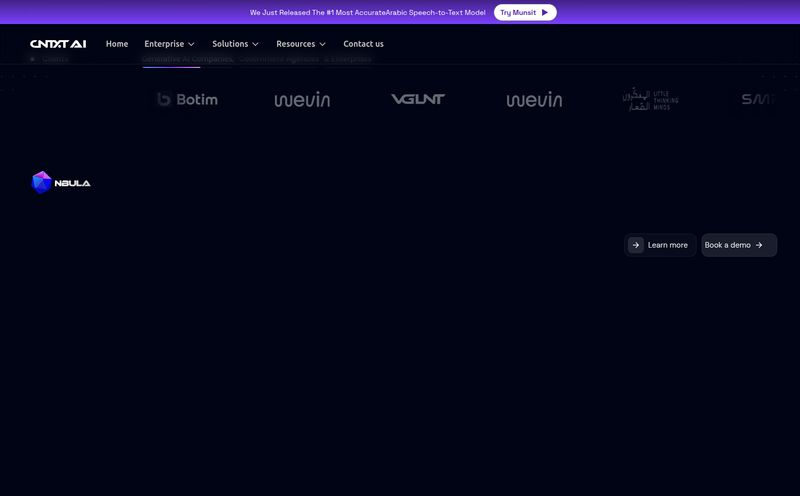As someone who’s been neck-deep in the tech world for years, I’ve seen my fair share of tools come and go. Some are revolutionary, some are duds, and some... some are like digital ghosts. They appear as a brilliant flash of an idea, generate some buzz, and then vanish into the ether. Today, I want to talk about one of these fascinating ghosts: a tool called SamaritanAI.
If you're a developer, you know the feeling. You're tasked with fixing a bug or adding a feature to a massive, sprawling codebase you’ve never seen before. It's a maze. A digital labyrinth. And you've just been handed the keys with zero instructions. I've spent more hours than I'd care to admit grep-ing my way through a new repository, trying to piece together how a single button click triggers a cascade of events across a dozen different files. It's a headache we've all learned to live with.
So when I stumbled upon the concept of SamaritanAI, my ears perked up. The promise was simple, yet profound: an AI tool that helps you understand codebases by visualizing them. Not as a boring, hierarchical list of files, but as a living, breathing network graph. An architectural blueprint for a digital skyscraper. Sounds pretty cool, right?
So, What Was SamaritanAI Supposed to Be?
At its core, SamaritanAI was designed to be a developer's best friend for navigating the unknown. The main idea was to ingest a large codebase and convert its file system into a graph. Think of it like this: instead of a family tree, you get a social network map. You can see not just what files exist, but how they're all connected, which functions call which, and where the real action happens.
This approach alone is a huge step up. But they didn't stop there. The real magic was in its AI-assisted features, aimed squarely at one of the most daunting tasks for many developers: contributing to open-source.
Your AI Guide for GitHub Issues
Let’s be honest, jumping into a huge open-source project like Kubernetes or even a moderately complex one can be intimidating. You find a 'good first issue' on GitHub, you're excited to contribute, but then you're faced with a million lines of code. Where do you even start?
SamaritanAI’s answer was to use AI to bridge that gap. The workflow was supposed to be: you feed it a GitHub issue description, and the tool, using a technique called Retrieval-Augmented Generation (or RAG), would analyze the issue and the entire codebase. Then, it would highlight the most probable files that you'd need to modify to solve the problem. It’s like having a senior dev looking over your shoulder and saying, “Pssst. You’ll probably want to start by looking at user_controller.js and auth_service.py.”
Lowering the Barrier for Everyone
In my experience, tools that lower the barrier to entry are always a net positive for the community. By simplifying the initial discovery phase, SamaritanAI aimed to make it easier for junior developers and outsiders to make meaningful contributions. This helps the projects get more support, and it helps new developers build their skills and resumes. A classic win-win.
The Dream vs. The Reality
Okay, so the idea is brilliant. A GPS for your code, powered by AI. I was genuinely excited. I wanted to try it, to see if it lived up to the hype. And this, my friends, is where our story takes a turn.
I went looking for the website, the product, the company. And I found this:

Visit SamaritanAI
Yep. The domain name, samaritanai.xyz, is for sale on GoDaddy. For a cool $4,999, you can own this piece of digital history. This is the startup equivalent of finding a 'For Lease' sign on the door of a hyped new restaurant a week after its grand opening. It's a bummer, for sure.
This discovery changes the conversation from a product review to a bit of a post-mortem. It's a digital ghost story. What happened? Did they run out of funding? Was the tech too difficult to implement reliably? We might never know. But we can still analyze the potential.
The Potential Upsides We Missed Out On
The pros of a tool like this are pretty obvious. It would drastically cut down on onboarding time for new developers. It would make debugging complex, interconnected systems much less of a nightmare. And it would, as I mentioned, be a fantastic gateway into the world of open-source software. The ability to get AI-generated starting points is a powerful concept that saves time and reduces frustration.
The Probable Hurdles It Faced
Of course, it wouldn't have been perfect. The effectiveness of any AI tool like this is heavily dependent on the quality of the input. If a codebase is a mess of spaghetti code, the graph visualization might just look like... well, a plate of spaghetti. Similarly, a poorly written GitHub issue description wouldn't give the AI much to work with. There’s a principle in computer science: garbage in, garbage out. You'd always need a skilled human developer to validate the AI’s suggestions and make the final call. You can't just blindly trust the machine, not yet anyway.
Is the Idea Dead? Not by a Long Shot.
While SamaritanAI itself may be a ghost, its spirit lives on. The idea of using AI to understand and navigate code is one of the hottest areas in developer tools right now. If the concept intrigues you, you're in luck. There are other players in this space.
Tools like Sourcegraph have been doing intelligent code search and navigation for years, and they are increasingly integrating AI features. Then there's CodeSee, which focuses specifically on visualizing codebases with interactive maps. And of course, we can't forget GitHub Copilot, which is more of a pair programmer but is getting smarter about understanding the context of an entire repository. The dream of SamaritanAI is being built, piece by piece, across the industry.
FAQs About SamaritanAI and AI Code Tools
- What was SamaritanAI supposed to do?
- SamaritanAI was a conceptual tool designed to help developers understand large codebases by turning them into visual network graphs. It also aimed to use AI to analyze GitHub issues and suggest which files needed to be changed to fix them.
- Is SamaritanAI still available?
- It appears not. The tool's domain name, samaritanai.xyz, is currently listed for sale, which strongly suggests the project is defunct or was never fully launched.
- What is RAG in the context of coding tools?
- RAG stands for Retrieval-Augmented Generation. In simple terms, it's a type of AI that can “look up” information from a specific knowledge base (like a whole codebase) before generating an answer. This allows it to provide more accurate and context-aware suggestions than a general-purpose AI model.
- Are there other tools like SamaritanAI?
- Yes! While not identical, tools like Sourcegraph, CodeSee, and features within GitHub Copilot are all working on solving the same problem: helping developers understand and work with complex code more efficiently using AI and visualization.
- Why is visualizing a codebase as a graph useful?
- A graph shows relationships and dependencies, not just file locations. This helps you understand the architecture and flow of logic in an application, which is much more intuitive than just reading through folders and files.
A Great Idea, If You Can Get It
The story of SamaritanAI is a bit of a letdown, I'll admit. It's a classic tale of a fantastic idea that, for whatever reason, didn't make it to the finish line. It serves as a good reminder of how tough the tech industry can be. But I choose not to see it as a failure. I see it as a signpost.
The very concept of SamaritanAI points to where we're headed. The future of software development isn't about replacing developers with AI, its' about empowering them with smarter tools. Tools that handle the tedious, time-consuming discovery work so we can focus on what we do best: building creative and robust solutions. SamaritanAI may be a ghost, but it’s one that’s showing us a very exciting future.
Reference and Sources
- GoDaddy Listing for samaritanai.xyz
- Sourcegraph - Intelligent Code Platform
- CodeSee - Visualize Your Codebase
- IBM Research Blog: What is RAG?



